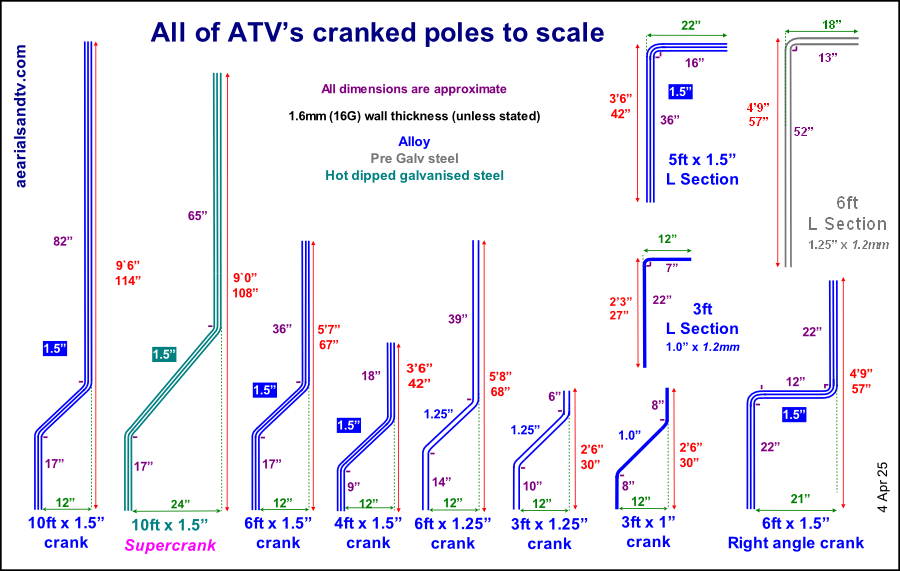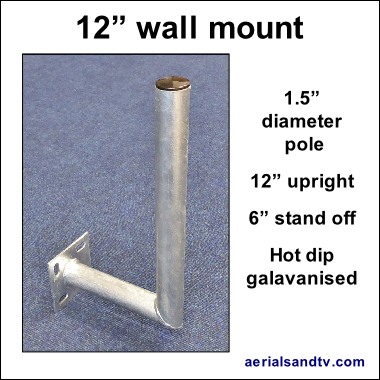Poles & Masts
All about poles and masts for the installation of aerials, CCTV, weather stations, RF data links etc etc
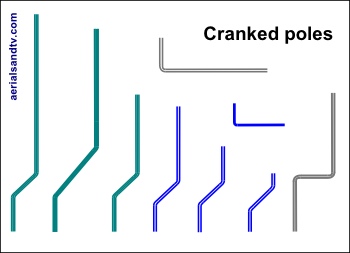
Subject list :
Poles & Masts including :
- Poles / Mast (varieties etc)
- Cranked poles
- Check the required stand off exactly!
- Satellite poles
- Pole recommendations incl :
- - pole lifetime warranty
- Wind loading on the pole
- Seam welded v extruded alloy poles
- Tile & slate mount
- Mounting loft aerials
- Use of longer poles
- Installing an aerial which is on a long pole
- “Double poles” : is this a bodge ?
- Pole mounting plate
- Pole / Mast caps
- Joining poles of different diameters incl :
- - Sleeving a 1.5" pole / Starlink into a scaffold pole
Bolting poles to brackets including :
Pole clamps including :
Installing a pole on a post
Weather station installations
Multi section poles / “Caravan poles”
Birds on your aerial
Guy wire supported poles
Health & safety disclaimer
Plate mounts also satellite mount / patio mount / flat roof mounting tray
Also see :
Poles on test
Our pole (and bracket) lifetime warranty
When deciding how strong to make your install remember that the weight of the aerial/satellite/weather station is almost * irrelevant, it’s the wind loading that counts !
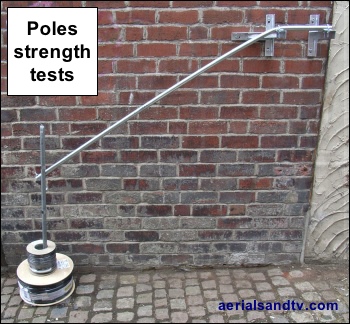
* If the antenna on the end of the pole is being whipped about significantly by the wind then the weight of it does become significant in the amount of force being put on the pole and brackets, but the fact it’s being moved about so much is a function of the antennas windloading anyway (plus the lack of rigidity in the pole and/or brackets) ! Basically, if possible, minimise wind load and/or maximise the rigidity of the pole.
Remember, if you’ve got a big aerial on a long pole and it’s accessible, if particularly high winds are forecast it is sometimes possible to temporarily lower the install for the duration of the storm, use of stainless V bolts greatly assists in this…..
Poles / Masts
Who would have thought that something as simple as a TV aerial pole could have so many different types with such wide variations in quality…...
Size for size Steel poles are stronger than alloy poles, so why don’t we stock them (not basic pre galv ones anyway) ? Well, in the first place steel poles are not actually that much stronger than alloy ones, but more importantly, even though they’re galvanised they rust. How come ? Virtually all steel masting sold in this country is "Pre-Galv", that is to say the metal is pre-galvanised before being formed into a tube. On Pre Galv products the galvanising is much thinner than "Hot Dipped Galvanising" and furthermore the weld line up the side of the tube is generally just painted, if that…. Incidentally, steel poles will generally rust from the inside as shown in the picture below. Finally all Pre-Galv products have an exposed unprotected edge where they are cut or stamped out and this is where rust usually starts. Don’t get me wrong, a steel pole will take years (many many years if it’s hot dip galvanised ! ) to rust through to the point where it becomes so thin that a strong gust of wind will break it, but eventually, it will come down.
See our tests of aerial / satellite poles and brackets
and ATV's pole and bracket lifetime warranty.
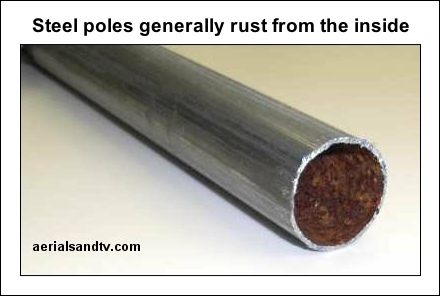
Steel poles usually rust from the inside, though this only applies to “pre-galv”, not hot dip galv, the latter is a rather different ball game….
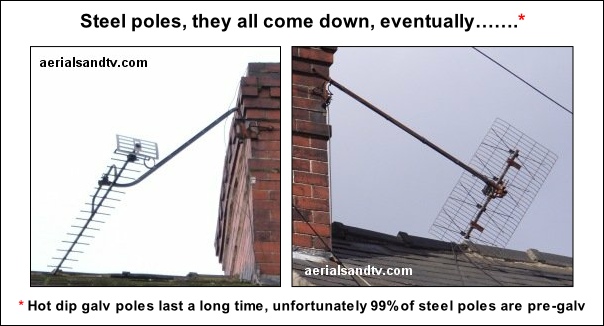
Then we have Alloy poles. Not only are they rust free but they will flex slightly in the wind (some think this absorbs some of the shock loading) and they’re lighter as well. Both of these will help in putting a little less strain on the bracket, and on your brickwork. Unfortunately alloy is more expensive and (size for size) is slightly weaker than steel unless the appropriate gauge / diameter is used, see pole test results.
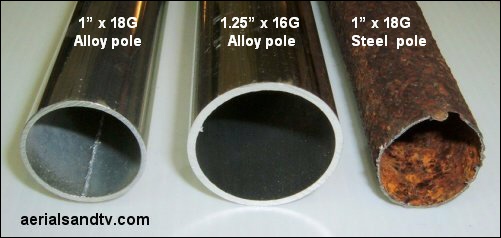
This is one of my favourite pictures on the entire site. Nothing shows so vividly the differing qualities of materials used in this trade. Remember that the 1” steel pole was originally galvanised, although as we have already seen it was only “Pre-Galv”. If one looks carefully one can see where the wall became so thin that eventually the pole snapped in the wind.
Compare the two alloy poles in the above picture, the 1” pole’s smaller size and thinner wall are immediately obvious and a 6ft length weighs about 450g. The 1.25” x 16 gauge pole’s superiority is plain to see and a 6 foot length of this pole has a weight of around 750g, that’s 67% more metal....
In normal usage it will never fail, and if it does we’ll replace it free (see our pole lifetime warranty).
Let’s compare the three commonly supplied varieties of 6 ft alloy mast. They can be either straight or of the cranked/swan neck variety. The first type is 1" diameter x 18 gauge, they are the equivalent of 3” fence posts and we would not use a 6ft pole of this type for a TV aerial under any circumstances. In fact I am prepared to say publicly that any installer using such a pole (particularly with a large aerial) should be wearing a Stetson. Having said that, if the installation shown below was done by the house owner one cannot necessarily blame him. I was in a DIY shed the other day and the only 6ft pole they sell is a 1”x 18 gauge, we call them “Screwfix Specials”, and they certainly wouldn’t have a pole lifetime warranty !
I wonder where the installer who fitted this 6ft x 1” alloy pole tied up his horse ?
And he (or she !) has only used a 6” chimney bracket, and it’s a cheapo pressed one at that.
Incidentally, why has Roy (as in Rogers, as in cowboy) fitted a 5 element DAB aerial ? Very few people actually need one of those, could it possibly be was so he could charge more ?
Actually, I suspect this pole could be an extruded one.
See our tests of Poles, and also Cowboys’ Locker
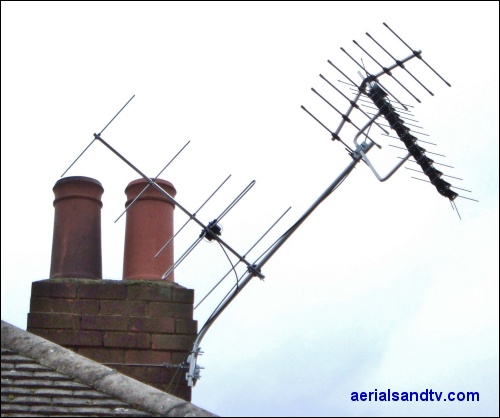
The second variety is the 1.25" x 18 gauge (=1.2mm) aerial pole. They are a bit stronger than the 1” type and fine for smaller aerials, provided the top V bolt is not over tightened which can crush the tubing and eventually lead to failure.
Finally we have the third type and the only type we sell (straight or cranked). This is the Rolls Royce of the 6ft aerial poles and they are 1.25" x 16 gauge (1.6mm) alloy, in normal usage they will never fail and if it does we'll replace it, hold on, I've already said this above haven't I and I wouldn't want to be repetitive now would I ?
Why doesn’t everyone use the latter type of pole ?
Well, two main reasons spring to mind :
They’re more expensive and DIY shops don’t generally tend to sell them.
If a weaker pole (particularly a 6ft x 1") is installed by an aerial rigger, they probably want some "repeat business".
Cranked (or "swan neck") poles
These are sometimes required if the pole has to clear an obstruction (but sometimes to get closer to the transmitter....), the eaves for instance. You can use a bigger bracket instead of, or as well as, a cranked pole. You should always leave a gap of about 2" (and check your stand off exactly) to prevent high winds causing the pole to bang against the fascia (or gutter) and also to facilitate maintenance of the latter. Cranked poles can also be used to move an aerial’s position laterally if this is required to give the antenna more of a clear path to the transmitter or keep the aerial out of any smoke.
Approximate overall clearance on a 9”x 9” wall bracket with a cranked pole is around 17”.
For those requiring more “off set” we have a 10ft Supercrank pole in 1.5” x 16G/1.6mm hot dipped galvanised steel. These are particularly suitable for buildings with large overhangs on the fascias. Fitting these is much neater than huge T & Ks and a straight pole. The 10ft Supercrank pole is sometimes used "upside down" to crank a pole back over the roof if birds’ little presents to you are a problem.......
All offsets are approximate, if this measurement is critical phone to check the exact figure.
The poles' off sets are in green on the diagram below. (link)
A little flex in an aerial pole is no bad thing, it helps take some of the shock force out of the wind loading, but satellite poles must be rock steady if you are keep the dish focused on that little “geostationary” transmitter 22,000 miles above the Equator. Furthermore satellite dishes have high windloading..... Thus we stock some ultra strong masts suitable for use with satellite dishes. The use of saddles is recommended particularly with the cranked poles.
How strong are these poles ? See Poles on test.
All these poles are equally suitable as ultra heavy duty aerial poles.
In order to qualify for our pole lifetime warranty our satellite poles (other than the scaffold poles) must only be used for dishes up to 60cm or Starlink (or up to 80cm for the 6ft x 2")
Straight satellite poles :
3ft x 1.25" x 1.6mm (alloy)
4ft x 1.5" x 1.6mm (alloy)
6ft x 1.5in x 1.6mm (alloy)
6ft x 2.0in x 2.0mm (alloy)
8ft x 2.0in x 2.0mm (alloy)
10ft x 2.0in x 2.0mm (alloy)
Cranked satellite poles :
3ft x 1.25in x 1.6mm cranked (alloy)
4ft x 1.5in x 1.6mm cranked (hot dip galvanised steel)
6ft x 1.5in x 1.6mm cranked (alloy)
In addition we stock ultra heavy duty alloy scaffold poles (sold as : 4ft, 2m, 8ft, 10ft or 12ft) and these are suitable for :
- Zone 1 dishes or Starlink up to 12ft
- dishes up to 60cm at 10ft length
- dishes up to 1m at 8ft length.
Most Zone 1 Sky / Freesat dishes will also fit on a 2" or 1.5" pole (though you will need a V bolt ), but Zone 2 dishes [or old Zone1s fitted with the small "L" pole] will, for some ironic reason, only take 1.25" poles. Brain dead or what ?
Also see plate mounts / satellite mounts.
Pole recommendations
Poles on sale here.
Generally any of our poles are suitable for any aerial, but, bearing in mind wind loading considerations, we have a few specific "4in fence post" recommendations, and these are to be followed to qualify for our pole lifetime warranty. On the other hand, small aerials, particularly Collinear types (e.g. Helium antennas), will put significantly less wind load on the pole and brackets, in fact the actual wind loading on the pole will be higher than that of the aerial !
Anyway, our 6ft x 1.25” poles are suitable for any aerial we stock, though the 44” (“surcharge avoider”) versions are even stronger.
We do not normally recommend fitting any TV aerial or multi element FM/DAB aerial on a 6ft x 1in pole although you might be alright with a DM18Log or an FM or DAB dipole. Six foot x 1in poles are excluded from our pole lifetime warranty.
If fitting an XB16 aerial on a 10 ft pole we only recommend the 2" variety, the same applies if fitting multiple aerials on a 10ft pole. An XB10 aerial would be unlikely to break a 10ft x 1.5in pole but it may move around a bit in a high wind......
The 8ft x 1.5" pole is pretty much strong enough for any aerial though, as is the 12ft/3.6m x 2in x 2.0mm.
We don’t recommend fitting XB16 aerials on 10ft cranks (or 10ft Supercranks) unless cut down by at least one foot, and preferably two foot in exposed locations.
Longer pole recommendations (16 ft plus).
The 4ft x 2in satellite pole is suitable for dishes up to 1m. The other satellite poles are only suitable for dishes up to 60cm, particularly in exposed locations.
Any of our satellite poles are suitable for any aerial (or aerials) under any conditions.
The 1.25in L section plate mount will take any aerial or a satellite dish up to 60cm. The models of 2in plate mounts will take a 1m dish.
Wind loading on the pole
For a very small aerial (e.g. a data link or Helium antenna) the windloading on the pole will almost certainly be far more significant than that of the antenna and this has major implications when working out one's maximum recommended pole length. I'll be honest I don't actually know what the windload on poles is, but what I do know is that it is spread all up the pole and not concentrated at its top point (where any aerial is usually mounted). This is a very important because it is the distance from the point of wind load to the the point of maximum stress (almost always at the upper most V bolt) where it is most likely to fail. Assuming even wind loading up the pole* the effective point of that loading is only mid way up the pole, i.e. halving the strain on the pole compared with having the effective point of wind loading at the top. It's a bit like how centre of mass works.
* This is probably incorrect in most localities, wind is usually greater with increased height due to surrounding buildings or trees but that actually means less force on the pole (for a given wind speed) at its bottom end anyway.
Tile & Slate Mount
Strong brackets and poles are all very well, but what if you don’t have a chimney to fit them on and/or the roof overhang is large so huge brackets are needed ? Even worse it may be a hip roof so has no gable end, so you need a long pole to get any aerial (or weatherstation or whatever) above the roof. That seems a hell of a lot of hardware particularly if you only need to put a little aerial or RF link or CCTV camera up there. Well there is an alternative, the tile & slate mount, illustrated in teh adjacent picture). It must be stressed these are really only suitable for small low wind load items and the stub pole must not be extended. The manufacturers do say they’ve been tested in a wind tunnel with a zone 1 satellite dish but surely that depends on the strength of the tiles and their fixings ? Personally I’d only really recommend mounting an aerial (or similar) with a wind loading of less than about 50N.
The mount is non invasive and doesn’t require any drilling, it works by three cleats being slid under three tiles then they’re clamped to the “T frame” mounted on top. Self adhesive pads (supplied) are then fitted at the contact point with the tiles to reduce the stress loads and lessen the risk of cracking the tile. They are not suitable for small “Rosemary” type tiles or roofs in poor condition.
Available to special order
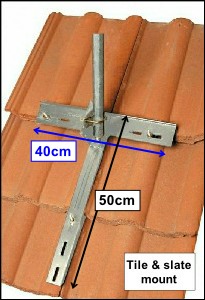
Installing loft aerials (sold here)
Particularly since switchover aerials in loft aerials can work fine in reasonable signal areas and we sell the above “Loft Kits” to mount the antennas. You can just suspend the aerials from string though this can be awkward when aligning the antenna ! The loft kits come with a 2 way surface bracket, these mount perpendicular or parallel as shown in the pictures. The picture in the centre shows a further adaptation, if the L section pole is mounted in the bracket’s side it can then be rotated to give a diagonal pole ! Some people use also use the 2 way brackets (with large jubilee clips) to attach small items, e.g. CCTV cameras, to lamp posts or similar, also of use for doing this are the multi angle brackets.
Although some people use loft kits to mount installations outside, we don’t recommend it, unless it’s a low windload aerial (e.g. an FM or DAB dipole) in a sheltered area.
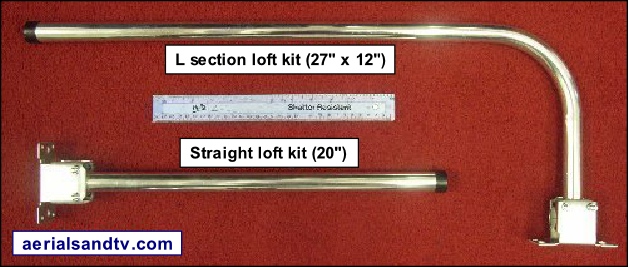
This picture below also illustrates the fact an aerial can be mounted from the top as well as the bottom. Ideally the pole wouldn’t pass through the aerial’s elements, but, because the aerial and pole are opposite polarities, it wouldn’t actually make much difference.
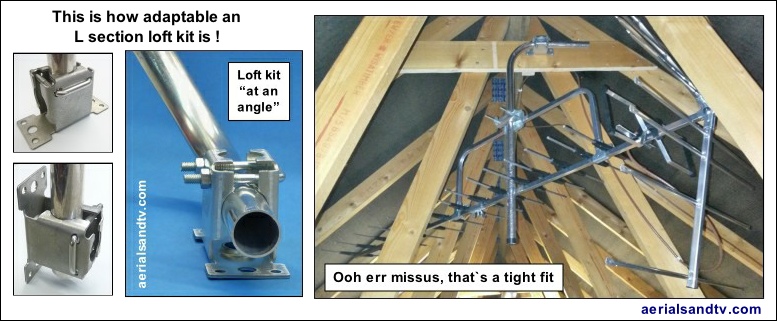
Pole / Mast Caps
Pole caps are plastic caps (or bungs) placed over (or inside) the ends of aerial masts. Their primary purpose is to prevent wind noise, though I have to say that worrying about the wind noise you’d get from the pole, when there’s an aerial mounted on the end of it, is like the captain of the Titanic worrying how much it’ll cost to clean his uniform when it gets soaked as the freezing North Atlantic water creeps inexorably up his ship...... Actually, it must be said, under certain conditions, you can get a low whistle created when wind blows across the end of a pole, but it’s fairly rare and not usually that loud either. Other uses of pole caps are for masts concreted into the ground, to stop them filling with water !
You could argue that steel poles (Pre Galv, not hot dip galvanized, the latter is far better….) benefit from mast caps, because they often rust from the inside first, and the cap helps to prevent the ingress of water, though they also prevent it drying out as well, so just fit one to the top of the pole (the last time I checked water flowed down hill). Actually it’s probably better to avoid caps in the bottom of poles (or drill holes in the bottom one) because you don’t want them filling them water do you ? We sell pole caps (1”, 1.25”, 1.5” and 2”) or you can make one out of decent quality insulation tape. Place a number of strips radially across the end of the pole, then run a length (stretched) round the outside of the pole to cover and strengthen them. Doing the latter is required for a scaffold poles because 2" pole caps don't fit them !
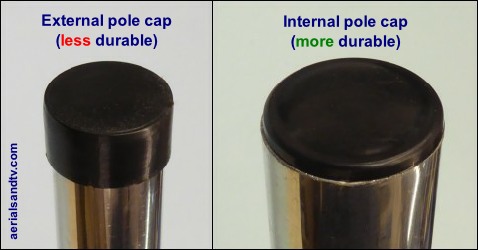
Note that external pole caps may be theoretically slightly more waterproof then internal fit types but in my experience the latter are significantly more durable. The former tend to harden in the sun, split and fall off. And anyway, if you’re only fitting a cap to the top (which we recommend) then being absolutely waterproof isn’t that important.
Birds on your aerial (or, alliteratively, avians on your antenna)
Note : Birds find vertically polarised aerials rather less appealing !
Assuming that their aerial is sufficiently strong I don’t suppose most people mind birds perching on them. After all they may well be tired and shagged out following a prolonged squawk.
However if your aerial is situated over the drive where you park your car, and the aforementioned bird is doing what birds do (or should that be doo doo) then you might not be so hospitable.
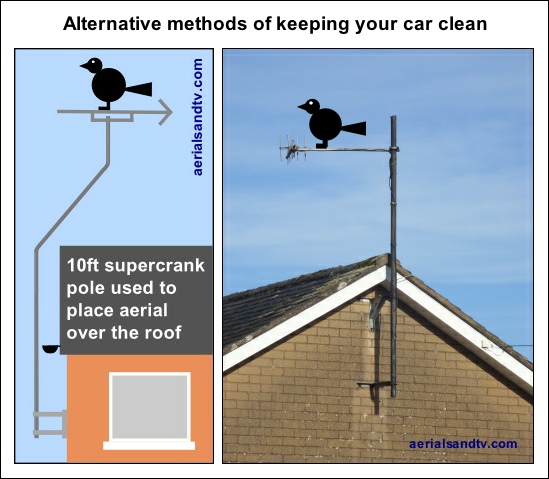
You have a few options, apart, of course, from buying a cat with an interest in aerials.
The best line of attack is more a case of defence, and that is to mount the aerial* where the avians gifts to you won’t cause a problem. Generally speaking this involves erecting the aerial over the roof. If it’s on a chimney then that would normally be the case anyway, but if it’s installed on a wall you might need to use cranked pole (usually a “Supercrank"), or an L Section pole or even a side pole to shift the antenna back over the roof. Use of a side pole would probably require a 2x1 or 2x2 clamp and a suitable length of pole.
If all of the above ideas are unsuitable to solve your wildlife worry you could try using fishing line or tie wraps or plastic “anti bird” spikes (though the latter look horrible). String the fishing line across the top of your aerial, either from the top of the reflector down to the middle/front elements, or from the pole above the aerial to the same points if that is easier, as it would be with a Log Periodic type antenna.
Tie wraps can also be used to agitate the avians, leave the uncut lengths poking skywards, they don’t like it up ’em, apparently, similarly with the plastic anti bird spikes. However, I’m unconvinced how long either of these would last….. The major advantage of using fishing line over tie wraps is that is looks a lot neater. After all fishing line is supposed to be invisible (to fish at any rate). Make sure the fishing line is UV resistant though.
* Obviously you have to make sure that your aerial is sturdy enough to withstand our feathered friends sitting on it. What you don’t want, is a Bacofoil aerial !
Weather station installations
Our customers tell us there are a few different priorities when it comes to mounting weather stations. The wind loading of weather stations is generally much less significant than it is with aerials and satellites, particularly large aerials and satellites. That is to say you don’t need to worry so much about using larger brackets and stronger poles in case the install gets blown down in a gale, so that’s good news. On the other hand we’re also told that having a weather station on a bendy bracket and pole can induce errors in the rain gauge measurements and wind speed readings. So, from that point of view you actually need stronger (i.e. more rigid) bracket and poles ! Anyway, I’m pleased to have clarified that for you........
On the right we have a neat weather station installation which was put up by Nick Beer. He’s mounted his “Davis Vantage View” weather station on a Supercrank pole (sold here) which is itself mounted on a 9x9 wall bracket (one 9x9 bracket with a 10ft Supercrank is only suitable for a low wind load aerial or weather station). Nick reports that the station is stable in use and provides accurate readings. This install gets the station well away from the walls and/or roof plus it gives it a 6ft clearance above the roof line which, I’m told, is a good idea to ensure maximum wind speed accuracy. Note how Nick has painted the bracket and the lower part of the pole the same colour as the wall so as to be as unobtrusive as possible (also see low profile brackets) though it’s still worth using a galvanised bracket because it won’t rust when the paint wears or flakes off.
One last thing, many weather stations need regular maintenance which generally requires the V bolts (which install the pole on the bracket) to be repeatedly slackened and re-tightened each time. This is a double problem because that wears off the relatively thin zinc plating and increases the chances of rust, and that rust then makes undoing the nuts more and more problematic (generally [plated] V bolts rust first on a good quality install). Thus we strongly recommend the use of stainless steel Vs (sole here)……
Also see "pole on a post".
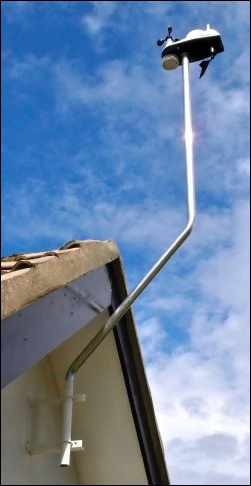
Joining poles of different diameters
One problem you occasionally get with some weather stations (and also certain antennas) is they have a mounting socket which will only accept a particular size pole, so, what do you do if you want to fit the station on the end of a pole of larger diameter ? You can use a mast clamp capable of parallel use to attach a short section of smaller diameter pole on the end but that looks a bit Heath Robinson (remember him.....). An alternative is to use a 2in to 1.25in pole coupler (see below), or fit a short section of the smaller diameter pole inside the larger one using suitable sleeving if necessary. Obviously the longer the overlap between the two sections of pole the stronger and more stable the joint will be. Lastly put a small bolt through the joint to stop the poles slipping.
External / internal diameters of poles :
1.0in by 18G / 1.2mm = 25.3mm / 22.5mm
1.25in by 16G / 1.6mm = 31.7mm / 28.3mm
1.5in by 16G / 1.6mm = 38.1mm / 34.7mm
2.0in by 16G / 1.6mm = 50.9mm / 47.5mm
2.0in by 14G / 2.0mm = 50.9mm / 46.7mm
Scaffold pole
48.3mm by 4.0mm = 48.3mm / 40.3mm
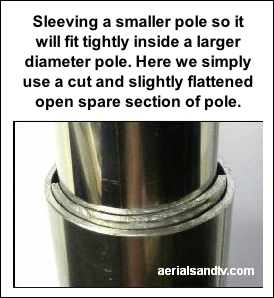
Diagram of a 1.5in pole sleeved into a scaffold pole. This is a good way of making an 18ft pole out of an 10ft x 1.5in pole and a 10ft scaffold pole. This is actually much stronger than an 18ft x 2in pole (even with a 2.0mm wall) and, on balance, superior to an 18ft scaffold pole, think Eiffel Tower. Additional benefits are it’s lighter than an 18ft scaffold pole and also cheaper, particularly as it avoids the “direct from the supplier” additional carriage charge !
See Bill’s article on sleevinga 1.5" pole into a satellite pole.
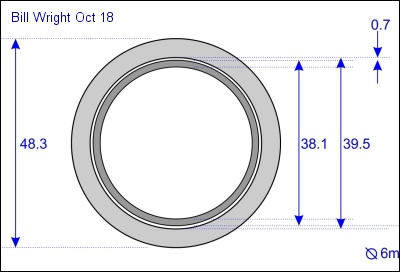
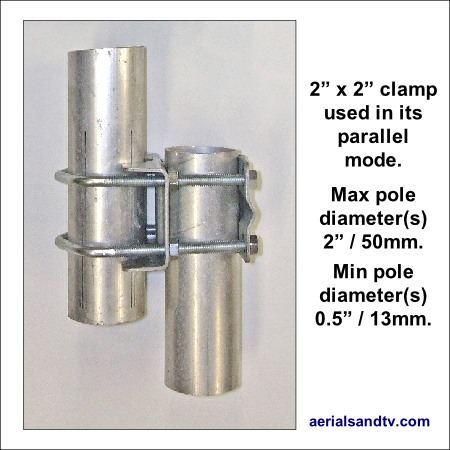
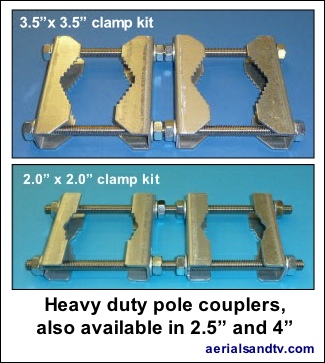
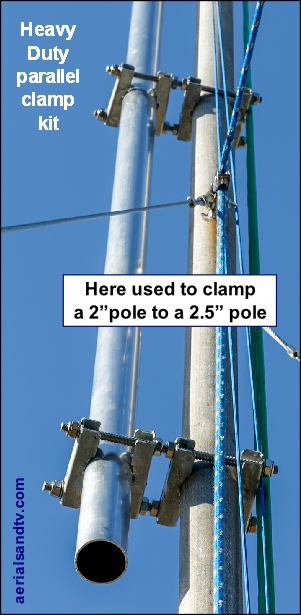
Plate mounts / Satellite mounts / Patio mounts
Plate mounts are available with a 3ft straight or L section at 1.25 inch or 2 inch diameter.
These plate mounts are often used to install satellite dishes, particularly large satellite dishes, but are equally suitable for a neat install of aerials or RF links or whatever. They’re all heavy duty, even the 1.25in is pretty strong (we loaded it with 65Kg and it still hadn’t failed….) and are all hot dip galvanised steel. See dimensions of our plate mounts. Picture below left.
For an installation on a flat roof (hence the term patio mount), a heavy duty flat roof mounting kit (also called a non penetrating roof mount) is available, see picture below. This product takes 18in square paving slabs.
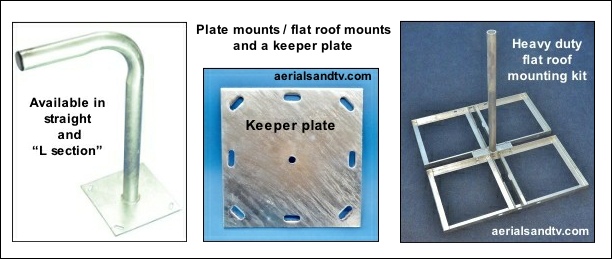
A smaller version of the plate mount is the 12" wall mount. It is perfect for installs which do not require a large stand off and are fitted near the top of a wall.
Although we do not usually recommend installing onto a fascia this mount would be ideal for that.
It is strong and rugged but best of all, being hot dip galvanised, it is very resistant to corrosion.
Health & Safety Disclaimer
There could be some Health & Safety Bollocks ruling* about trying to fit your own aerial, so consider this sentence to be a concession to that.
They could call it the “Rod Hull Rule”.
It’s pity he didn’t fall on that bleedin’ bird isn’t it ?
Or perhaps he did ?
Is that a tautology ?
Or, put another way, gravity plus height is a bad combination, don’t fall off the ladder.
If in any doubt about this scientific fact, don’t do the job.
But see basic ladder safety.......


